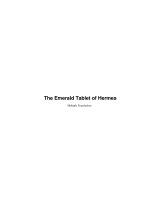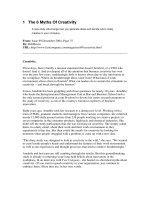Tài liệu The Economic Implications of Fewer International Higher Education Students in Australia ppt
Bạn đang xem bản rút gọn của tài liệu. Xem và tải ngay bản đầy đủ của tài liệu tại đây (355.75 KB, 44 trang )
TheEconomicImplicationsofFewer
InternationalHigherEducation
StudentsinAustralia
JohnPhillimoreandPaulKoshy
TheJohnCurtinInstituteofPublicPolicy
CurtinUniversity
for
AustralianTechnologyNetworkofUniversities
FinalReport
August2010
TheEconomicImplicationsofFewer
InternationalHigherEducation
StudentsinAustralia
JohnPhillimoreandPaulKoshy
TheJohnCurtinInstituteofPublicPolicy
CurtinUniversityofTechnology
for
AustralianTechnologyNetworkofUniversities
FinalReport
August2010
ContactDetails:
ProfessorJohnPhillimore
TheJohnCurtinInstituteofPublicPolicy
CurtinUniversity
GPOBoxU1987
PerthWA6845
Ph:0892661111
E‐mail:
Contents
KeyPoints 1
ExecutiveSummary 3
1 Introduction 10
2 InternationalHigherEducationinAustralia 12
3 TheEconomicImpactofInternationalHigherEducationinAustralia 18
4 RecentTrends,ProspectsandScenarios 24
5 ProjectionsforHigherEducation:2010–2015 29
6 ImplicationsfortheHigherEducationSectorandGovernment 37
TheEconomicImplicationsofFewerInternationalHigherEducationStudentsinAustralia
1
Key Points
1. International education is Australia’s third largest export industry, generating $18
billioninexportsin2009.Itis50%largerthantourism‐relatedtravel,andhasgrown
by94%since2004.
2. In 2009, there were 629,918 international students in Australia, of whom 203,324
wereinhighereducation,232,475attendedaVETproviderand135,141wereinan
Englishlanguagecourse.
3. Highereducationisthemosteconomicallysignificantpartofthesector.With32%of
the total student market it generates 57% of export revenue. On average, each
internationalhighereducationstudentstudyinginAustraliagenerates$50,874.Just
overa
third(36%)ofstudentexpenditurewasonfees;therestwasspentongoods
andservicesthroughouttherestoftheeconomy(mainlyaccommodation,cafesand
restaurants;andretailtrade)–generatingmorejobsandincome.
4. Totalvalueaddedgeneratedbyinternationalhighereducationstudents – including
bothstudentand
studentvisitors’expenditure–was$9.3billionin2009–or0.76%
ofGDP;ofthis,$3.5billionwasintheeducationsector,theother$5.8billionwasin
therestoftheeconomy.
5. This resulted in additional employment of 102,387 FTE positions of which 83,050
were created outside the education sector. For every two international highe r
educationstudentsenrolledinanAustralianuniversity,oneextrajobiscreated.
6. Internationalhighereducationisnowunderseverepressureowingtoseveralrecent
globalanddomesticdevelopmentssuchasastrongerAustraliandollar;theimpactof
theglobalfinancialcrisis;increasedcompetitionfromothercountriessuchastheUS;
reputationaldamagecausedbyattacksoninternational(especiallyIndian)students;
the collapse of some private colleges; major changes to student visa and skilled
migration rules; and the current election discussion about immigration and
populationissues.Theimpactofmostofthesefactorshasyettobefullyfeltandis
likelytobereflectedinfuturedataoncommencementsandvisagrants.
7. However, there are already indications of a negative trend. Commencements, as
measuredbyAustralianEducationInternational(AEI),showeda6.3%declineforthe
year to June 2010, with ELICOS commencements being hardest hit, down 20.5%.
Further reports from agents and providers suggest enrolments could fall by 30 to
40%. This is worrying for the higher education sector as ELICOS is a common
pathwayintohighereducationinsubsequentyears.
8. Data on student visa grants from the Department of Immigration and Citizenship
showasimilardownwardtrend.Highereducationvisagrantsdeclinedin2009‐10by
11.5%, mostof which was attributableto a fall invisas fromIndia. Offshore higher
educationvisagrantsfellby24.9%overthisperiod.Thesefigureswereonlyslightly
offsetbyincreasesinpostgraduateresearchstudentsreceivingvisas.
9. Modelling of the potential economic impact of a decline in commencements and
enrolmentswasundertakencomparingabaselineofmodest(3%)growth from2010
TheEconomicImplicationsofFewerInternationalHigherEducationStudentsinAustralia
2
withthreeplausiblescenariosfortheperiod2010‐2015: (i) a ‘Sideways’scenarioin
whichcommencementsdeclineby10%in2011,remainconstantover2012,before
returning to Baseline growth of 3% per annum; (ii) a ‘Trough’ scenario, where
commencements are hit by rolling decline, with a decrease in student numbers of
20%ineachof2011,2012and2013,beforeexpandingagainby3%perannumover
eachof2014and2015;and(iii)a‘PerfectStorm’scenarioinwhichcommencements
fall by 35% in 2011 then remain flat over 2012 and 2013, before returning to
Baselinegrowththereafter,albeitfromavastlyreducedbase.
10. Themodelling takesaccount of thefact that inhigher education,unlike in VETand
ELICOS,studentstendtohavelongerperiodsofattachmenttotheirinstitutionand
consequently there is a lag between reported declines in commencements and
declinesinenrolments.Thispipelineeffecthelpsexplainwhycurrentenrolmentsin
higher education have held uprelatively welldespite early indicatorsof declines in
commencements. Nevertheless, the impact of declining commencement numbers
eventuallymanifestsitselfinloweroverallenrolmentnumbers.
11. The modelling shows a decline in enrolments of just over 100,000 international
higher education students in 2015 between the Perfect Storm scenario and the
Baseline (148,419 versus 248,168 students). This would represent a loss of total
expenditureassociatedwiththeBaselinecaseofjustover$5.88billionin2015.
12. As a result, the overall impact of international higher education on the Australian
economyisseverelydiminished.ComparedtoaBaselineexpectationof$13.3billion
valueaddedin2015,theotherscenarios showvalueadded of between$7.9billion
(PerfectStorm)and $11.2 billion(Sideways).Employmentthroughout theeconomy
(includingineducation)isreducedto96,203FTEpositionsfortheSidewaysscenario,
88,082 under the Trough scenario, and just 67,823 jobs under the Perfect Storm
scenario,comparedwithanestimated figureof104,005in 2010–adropof36,182
FTEpositions.AgainsttheBaseline,thefallin2015is45,583FTEpositions.
13. For higher education institutions, revenue losses relative to the Baseline are
substantial under all scenarios with income gaps of between $2.6 and $7.0 billion
overtheperiod2011to2015.Thisisaseverehitespeciallyasthesectormovestoa
competitivedemand‐drivendomesticfundingmodelin2012.
14. Government needs to reconsider its policy settings. Higher education – the largest
economicandemploymentgeneratorinthesector,withtheleastproblemsinterms
of quality – is already suffering reduced enrolments andlower visa grants, in what
appearsto be acaseof significant‘collateral damage’arising frompolicymeasures
aimed mainly at other sectors, in a challenging international environment. Lower
prospectiveenrolmentsinhighereducationwillinturnlikelyhavenegativeimpacts
on other parts of the sector, in particular ELICOS providers, which have a close
relationship with higher education in providing pathway language tuition for
students intending to go on to university studies in Australia. A reinforcing
downward spiral is a definite possibility, with consequent negative impacts on
incomesandjobsacrosstheeconomyasawhole.
TheEconomicImplicationsofFewerInternationalHigherEducationStudentsinAustralia
3
Executive Summary
Introduction
Travelrelated education isthe third largestexportindustry in Australia, with $18billionof
exportsgeneratedin2009.Thismakesitalmost50%largerthantourism‐relatedtravel.
Thesector hasseenmarkedgrowthin recentyears,expandingby94%since2004.In2009,
therewere629,918internationalstudentsinAustralia.Ofthisfigure,203,324wereinhigher
education, 232,475 attended a VET provider, 135,141 we re in ELICOS and the remainder
wereeitherinSchools(27,506)orparticipatinginanon‐awardcourse.
However,acombinationoffactorsinthepast18months hasputtheinternationaleducation
sectorunderpressure.Preliminaryevidencesuggeststhattheentiresector couldseeadecline in
enrolmentsofbetween15to30%inthenearfuture.
AnydeclineintheinternationalstudentsectorhasimplicationsfortheAustralianeconomy.
A study in April 2009 by Access Economics found that in 2007‐8 the entire international
education sector in Australia contributed $12.6 billion to the Australian economy and was
responsiblefor total employmentof 126,240 FTEpositions.This current report updates the
Accessstudytomodeltheimpactontheeconomyofanumberofplausible scenariosfor the
highereducationsegmentofthemarketovertheperiodto2015.
InternationalHigherEducationinAustralia
Higher education was the prime initiator of the international student export success and
remains
themosteconomicallysignificantpartofthewholesector.
In 2009, therewere 203,324international higher educationstudents studyingat campuses
across Australia. This represented annual growth of 12.1% compared to 2008.
Commencements numbered 89,435, representing a 15.4% growth rate over the calendar
year.
Overall, higher education student numbers have gr own by 76% since 2002, at an
averagerateof8.4%growthperannum.
Approximately 56% of all international higher education students in 2009 were
undergraduates,with44%beingpostgraduates.Themostpopular‘b roadfieldofeducation’,
was“ManagementandCommerce”whichaccountedfor
48.3%ofenrolments.Nootherfield
accounted formore than 10% of enrolments, with “Engineeringand Related Technologies”
beingthesecondlargestat8.3%ofenrolments.
Theinternationalsegmentis dominatedbyChina(31.7%share)andIndia(13.5%),whohave
a combined share of 45.2% of all enrolments, an increase from 25% in 2003 and 11.1% in
TheEconomicImplicationsofFewerInternationalHigherEducationStudentsinAustralia
4
2000. The top five nationalities account for 62% of all enrolments, while the top ten
nationalitiesaccountforalmost75%.
Internationalhighereducationaccountsfor32%ofallinternationalstudents,butrepresents
57.5%ofallexportrevenues,ataround$10.3billionin2009.Onaverage,eachinternational
highereducationstudentstudyingatanonshorecampusinAustraliagenerated$50,874.By
comparison,eachinternationalVETstudentgenerated$20,647inexportincome.
TheEconomicImpactofInternationalHigherEducationinAustralia
This study applies a standard economic model to determine the impact of international
highereducationontheAustralianeconomy.
The majority of this impact occurs as a result of higher education student expenditure in
Australia.In2009,thisamountedto$10.3billionbeingspentby203,324studentsandhada
total value added contribution to the economy of $9.3 billion at $45,016 per student. This
resultedinthecreationof99,923FTEpositionsintheAustraliaeconomy.
These impacts flow from international student expenditure only. In addition, visits to
international students generated expenditure in Australia of around $233 million, and
createdvalueaddedofaround$184millionandemploymentequalto2,464FTEpositions.
Combined, therefore, international higher education student and student visitors’
expenditurein2009wasequalto$10.6billion oraround$51,735perstudent.Theeconomic
impactintermsofvalueaddedcontributionswasconsiderable.Educationalonebenefitedby
$3.5billion,with the restof the economyseeinganincrease in valueadded of $5.8 billion.
Totalvalueaddedcreatedthroughonshoreinternationalhighereducationwasequalto$9.3
billionor$45,916perstudent.Thisresultedin employmentequalto102,387FTEpositionsor
around 0.51 FTE positions per international student. Approximately 83,050 of these FTE
positionswerecreatedoutsidetheeducationsector.
State and territory shares of value added calculated on
the basis of their shares of
international student enrolments in 2009 are reported in Table A below. These show that
internationalonshoreeducationisnowabilliondollarindustryinitsownrightinNewSouth
WalesandVictoria.Inaddition,ithasanoverallimpactof$1.4billionin
Queensland.
TABLEA: EstimatedValueAddedfromOnshoreInternationalHigherEducation,$m
NSW VIC QLD WA SA TAS NT ACT Aust.
Education 1,181 1,101 537 298 232 46 7 91 3,494
Restoftheeconomy 1,975 1,841 899 498 387 77 12 152 5,842
TotalValueAdded 3,157 2,943 1,436 795 619 122 20 244 9,336
TheEconomicImplicationsofFewerInternationalHigherEducationStudentsinAustralia
5
Table B reports employment across the states and territories. These tend to be
commensurate with the level of expenditure associated with international students in the
state. New South Wales, Victoria and Queensland in particular have sizeable levels of FTE
positionsinEducationwhichareattributabletointernationalstudents,withtheotherstates
andterritorieshavingaconsiderableexposureaswell.
TABLEB: Estimated Employment from OnshoreInternationalHigher Education, Full‐
timeEquivalent(FTE)Positions
NSW VIC QLD WA SA TAS NT ACT Aust.
Education 6,538 6,095 2,974 1,282 1,648 253 41 505 19,337
Restoftheeconomy 28,079 26,177 12,773 5,553 7,029 1,088 174 2,168 83,050
TotalValueAdded 34,617 32,272 15,747 6,835 8, 677 1,341 215 2,672 102,387
As a general rule, for every one job created in higher education, another four jobs are
createdthroughouttherestoftheeconomy.
SpendingbyinternationalhighereducationstudentsandtheirvisitorsinAustraliatherefore
hasasubstantialimpactontheAustralianeconomy,contributing$9.3billiontototalvalue
added,representing0.76%ofGDP,andsupporting102387FTEpositions.
RecentTrends,ProspectsandScenarios
Therelativehealthoftheinternationaleducationexportsectorisnow underseverepressure
owingtoseveralinternationalanddomesticdevelopmentsoverthepast18months:
• AstrongerAustraliandollar;
• Theimpactoftheglobalfinancialcrisisondemandforplaces;
• Increased competition from other countries seeking international students, in
particulartheUSA;
• Reputationaldamagecausedbyhighlypublicisedattacksoninternationalstudents;
• Thecollapseofsomeprivatecolleges;
• Significantchangestostudentvisarulesandskilledmigration;and
• Thecurrentelectioncampaigndiscussionaboutimmigrationandpopulationissues.
Commencement data from AustralianEducation International (AEI) for the year‐to‐date to
June2010,showadeclineinoverallcommencementsintheonshoreinternationalsectorof
around6.3%onayearonyearbasis,althoughhighereducationisstilltrendingpositivewith
commencements to June of 54,326,up 5.64%onthe 2009 equivalentfigure of 51,339. The
otherthreekeysectorshaveallseenamarkeddeclineinenrolments:VETcommencements
toJune2010wereat67,046,downby4.45%;Schools at7,177,downby12.27%;andELICOS
at43,815,downby20.5%fromJune2009.
TheEconomicImplicationsofFewerInternationalHigherEducationStudentsinAustralia
6
TheELICOSsectorhasbeenhitparticularlyhard.ThepeakbodyforELICOSproviders,English
Australia,hassuggestedthat in view of the confluence of negative factorsrecently, ELICOS
enrolmentscouldfallbetween30to40%.
From the perspective of higher education, the marked decline in ELICOS commencements
could be a potential indicator of future decline. ELICOS providers typically prepare future
highereducationstudents intheirshortcoursestructures,as60%ofstudents‘pathway’into
the other sectors.Falls inELICOS enrolments thisyear more oftenthannot presage fallsin
highereducationcommencementsthenextyear.
Inadditiontoageneraldecline,thereisevidencefromcommencementdatatoindicatethat
asignificantfall innewenrolmentsacrosstheeducationsectorhasalreadyoccurredinthe
Indian market. Commencements by Indian students for the year‐to‐date for June were
22,670,downby13,300or37%over2009(yeartoJune)levelsof35,970.Thisincludedafall
inhighereducationcommencementsof1,898studentsto3,435,equalto36%onthe2009
equivalentfigureof5,333.Ofmoreconcernisthe86%fallinELICOScommencements–950
students in 2010 versus 6,754 students in 2009. This is widely attributable to the negative
pressaboutattacksonIndianstudentsinAustralia,andchangesinvisapolicy.
Looking forward in the context of all source markets, the Department of Immigration and
Citizenship(DIAC)’sgrantsforthehighereducationvisa–the573visa–declined in2009‐10
to 118,541, a decrease of 11.5% on 2008‐9 grants of 133,990, almost all of which is
attributabletoafallinIndianhighereducationvisagrants.Offsettingthischangesomewhat
was the relatively healthy outcomefor thepostgraduate research visa, which increased by
11.3%. Overall, combined onshore and offshore grants for higher education visas fell by
around10.2%in2009‐10.Significantly,combinedoffshoregrantsfellby23.4%in2009‐10.
ModellingtheEconomicImpactofDecliningInternationalHigherEducationEnrolments
Wemodelledpotentialimpactsfromadeclineininternationalstudents,initiallythroughthe
constructionofaBaselinecaseforgrowthwhichlargelyheldpriortocurrenttrends.Froma
growth forecast for 2010 of 214,212 students, we model this baseline and three realistic
scenarios.The‘Sideways’scenarioreflectedaninitialdropininternationalhighereducation
commencementsof10%on2010enrolmentlevelsin2011, with numbersstabilising at this
levelthrough 2012and2013 before areturn toBaseline growth ofaround 3% perannum.
The ‘Trough’scenario sawa decline in commencements of 20%in eachof 2011, 2012and
2013beforeareturnto3%growthinthetwoyearsthereafter.
The thirdscenario, the‘Perfect Storm’, sees commencement numbers fall by 35% between
2010and2011andthenremainflatin2012and2013beforereturningto3%trendgrowth.
Thesefalls incommencementnumberstranslateintostudentenrolmentprojectionsseenin
FigureA.
TheEconomicImplicationsofFewerInternationalHigherEducationStudentsinAustralia
7
FIGUREA: BaselineProjectionsandThreeScenariosforInternationalHigherEducation
EnrolmentsinAustralia,2010‐2015
Thefigures outlinedinFigureAtranslateintopotentiallyseriousoutcomesforthe Australian
economy. In the case of the Baseline, total expenditure associated with international
students(frombothstudents and visitors)increases in all years,rising from$11.4 billion in
2010to$12.7billionin2012and$14.9billionby2015.UndertheSidewaysscenario,student
expenditure in 2011 experiences a marginal increase of 2.6% on 2010 levels. Under the
Trough scenario, expenditure falls to $11.1 billion or 2.6% below 2010 levels. Total
expenditure declines much more sharply under the Perfect Storm scenario, where total
expenditurefallsto$10billionin2012,adecreaseof$3.1billionor12.2%oflevelsin2010.
WhensetagainsttheBaseline,thedecreasein totalexpenditureisevenmorepronounced.
Further, this is in many ways the true indication of the impact on the overall Australian
economy of a decline in onshore international student numbers, relative to expectations,
untilquiterecently, ofasteadygrowth of 3% per annumfrom2010. In theinstance of the
PerfectStormscenario,totalexpenditurein2012isaround24%belowwhereitwouldhave
beenunderthe Baseline. By2015, expenditurein the Perfect Stormscenario is$8.9billion,
around40%belowtheBaselineforecastof$14.9billion.
Thesedeclinesintotalexpenditurepatternstranslateintoidenticaloutcomes(inpercentage
terms)forvalueaddedandemploymentintheAustralianeconomy.ThiscanbeseeninTable
Cbelow.
2009 2010 2011 2012 2013 2014 2015
Baseline
203,324 214,212 220,610 227,198 233,983 240,971 248,168
Scenario1(Sideways)
203,324 214,212 212,491 209,526 206,472 205,530 210,530
Scenario2(Trough)
203,324 214,212 206,246 198,835 191,152 187,162 192,752
Scenario3(PerfectStorm)
203,324 214,212 196,878 179,152 159,659 146,054 148,419
140,000
165,000
190,000
215,000
240,000
265,000
TheEconomicImplicationsofFewerInternationalHigherEducationStudentsinAustralia
8
TABLEC: Baseline Projections and Three Scenarios: International Higher Education
EnrolmentsinAustralia,ImplicationsforEconomicValueAdded,2010‐2015,
$m
2010 2011 2012 2013 2014 2015
Baseline 10,134 10,690 11,277 11,896 12,549 13,239
Scenario1(Sideways) 10,134 10,297 10,400 10,497 10,704 11,231
Scenario2(Trough) 10,134
9,994 9,869 9,718 9,747 10,282
Scenario3(PerfectStorm) 10,134
9,540 8,892 8,117 7,606 7,917
Employment in Australia, due to international higher education, is projected to reach
104,005FTEpositionsin2010.Inallthreescenariosmodelled,decliningenrolmentsin2011
result in a decline in employment in that year, with a recovery only taking place as
enrolment levels recover after 2013(see Table D). Under the Perfect Storm scenario,
employmentduetointernationalhighereducationdeclinesto84,899FTEpositionsin2012,
adecreaseof19,106.By2015,employmentis67,823,afallofalmost36,182from2010and
around45,583fewerjobsthanundertheBaselinefor2015‐afallof40.2%.
TABLED: Baseline Projections and Three Scenarios:International Higher Education
Enrolments in Australia, Implications for Employment, 2010‐2015, FTE
positions.
2010 2011 2012 2013 2014 2015
Baseline 104,005 106,333 107,668 109,548 111,460 113,406
Scenario1(Sideways) 104,005 102,420 99,294 96,668 95,067 96,206
Scenario2(Trough) 104,005
99,409 94,227 89,495 86,571 88,082
Scenario3(PerfectStorm ) 104,005
94,894 84,899 74,750 67,557 67,823
These findings have implications at the state and territory level. For instance, under the
PerfectStorm scenario,employmentassociatedwithinternational students inNSWin2015
will decrease to 32,084 FTE positions, down 3,080 from 35,164 positions in 2010.
ImplicationsfortheHigherEducationSectorandGovernment
Themostobviousimpactforthehighereducationsectorisintermsofrevenueloss,whichis
substantial in all scenarios relative to the moderate Baselinecase ($23.7 billion in revenue
overthefiveyearperiod).UndertheSidewaysscenario,thehighereducationsectorseesan
incomegaprelativetotheBaselineofaround$2.6billionovertheperiod2011to2015.
TheEconomicImplicationsofFewerInternationalHigherEducationStudentsinAustralia
9
AmorepronounceddownturnsuchasthatmodelledundertheTroughscenarioseesrevenue
fall16.8%relativetotheBaseline,orarevenuelossof$4.0billion.UnderthePerfectStorm
scenario,revenuescollapseoverthefiveyearperiodto$16.7billion,implyingalossof29.5%
ofallexpectedincomeundertheBaseline.Thislossisequaltoaround$7.0billion.
TABLEE: Baseline Projections and Three Scenarios:International Higher Education
EnrolmentsinAustralia,CumulativeFeeIncome,2011‐2015,$m,%
CumulativeProjected
FeeRevenue:2011‐15
ChangefromBaseline
2011‐2015
Changeas%of
Baseline2011‐2015
Baseline 23,677 ‐ ‐
Scenario1(Sideways) 21,087 ‐2,590 ‐10.9%
Scenario2(Trough) 19,691
‐3,986 ‐16.8%
Scenario3(PerfectStorm ) 16,698
‐6,979 ‐29.5%
Thelossinfeeincometranslatesintoquitesignificantprospectiveemploymentlossesinthe
Australian higher education sector. On the broad‐based modelling undertaken, between
2010 and 2011alone, theseare in orderofbetween402 FTEpositions underthe Sideways
scenario,982positionsundertheTroughscenarioand1,851underthePerfectStormwhere
thereisamoredramaticdeclineincommencements.Overtimetheselossesaresustainedif
studentnumbersdonotincrease.
Forgovernment,theimplicationsaretwo‐fold.First,thereisaneedforareconsiderationof
policy settings in view of the current international climate, particularly in regard to
immigration policy as it affects higher education. Second, government needs to examine
optionstomeetthechallengespresentedbythecurrentglobalanddomesticcircumstances
facingthesector,inviewofgovernment’sgoalsforhighereducationingeneral.
TheEconomicImplicationsofFewerInternationalHigherEducationStudentsinAustralia
10
1 Introduction
The purpose ofthis reportis to better understandthe impact of internationalstudents on
theAustralianeconomy,focusinginparticularontheeffectofpotentialreductionsinhigher
educationenrolments.
InternationaleducationisanAustralianexportsuccessstory.Fromasmallbaseit hasnow
become Australia’s third largest export sector behind coal and iron ore, and is the largest
service export sector in the economy, worth around $18 billion in 2009. There has been
rapid growth in recent years in the international education sector (see Table 1), with
student numbers almost doubling over the five years to 2009. The growth has been
distributedacrossthesector(exceptSchools),withboththeVET(299%) andELICOS(119%)
segmentsexperiencingespeciallyrapidgrowthsince2004.Thehighereducationsectorhas
seen51%growthinenrolmentsbetween2004and2009,comingoffanestablishedbase.
TABLE1: InternationalOnshoreStudentEnrolments,BySector,2004to2009
Sector 2004 2005 2006 2007 2008 2009
Growth
%
HigherEducation 150,736 162,688 169,591 174,254 181,392 203,324 51%
VET 58,208 65,580 82,532 119,646 174,558 232,475 299%
ELICOS 61,736 64,556 76,855 101,961 126,785 135,141 119%
Schools 27,311 25,093 24,471 26,764 28,308 27,506 1%
Other 25,942 26,248 26,426 27,299 30,123 31,472 21%
Total 323,933 344,165 379,875 449,924 541,166 629,918 94%
Source:AustralianEducationInternational(AEI)
12
Such growth has provided increased income for higher education institutions. The most
recently available consolidated figures on Australian higher education provider finances,
those for 2007 from the Department of Education, Employment and Workplace Relations
(DEEWR), show that the revenue item ‘Fee Paying Overseas Students’ was equal to $2.6
billion and accounted for around 15% of all revenue from continuing operations ($17.3
billion). While a proportion of this is from offshore operations, it does indicate the
importance of international students to the sector. This revenue enabled them to expand
opportunitiesforallstudentsanddevoteresourcestoresearchactivity.
Inadditionto
theimportanceoftheinternationalsectortohighereducation,studentsalso
hadastronglypositiveeconomicimpac t,boostingGDPandprovidingincreasednumbersof
jobsacrosstheAustralianeconomy.
However, a combination of factors in the past 18 months has put the international
education sector under pressure. As Universities Australia puts it, “we are faced with a
‘perfect storm’ of factors coming together to threaten Australia’s position as a preferred
destinationforaneducationalexperience”
3
.ThefactorscitedbyUAandothersinclude:
TheEconomicImplicationsofFewerInternationalHigherEducationStudentsinAustralia
11
• AstrongerAustraliandollar;
• Theimpactoftheglobalfinancialcrisisondemandforplaces;
• Increased competition from other countries seeking international students, in
particulartheUSA;
• Reputationaldamagecausedbyhighlypublicisedattacksoninternationalstudents;
• Thecollapseofsomeprivatecolleges;
• Significantchangestostudentvisarulesandskilledmigration;and
• Thecurrentelectioncampaigndiscussionaboutimmigrationandpopulationissues.
Thesefactorshavehadtheeffectofslowingordeclininginternationalstudentenrolments,
withprospectsofworsetocome.Theeffectsofpolicy‐inducedchangestostudentvisasand
skilled migration,
the most important of which came into effect only quite recently, are
likelytobeonlyseeninthecomingmonths.
Higher education was the prime initiator of the international student export success and
remains
themosteconomicallysignificantpartofthewholesector.Whilerecentchangesto
student visas andskilled migration aretargetedprimarily at otherparts of thesector (e.g.
private colleges), there is a real prospect that higher education institutions will also be
negativelyaffected,bothintheshortandlongterm–andthatthiscouldinturnadversely
impactontheAustralianeconomy.
This report attempts to assess the potential impacts on the economy of a number of
plausiblescenariosforinternationalhighereducationenrolmentsoverthenextfiveyears.It
providesabriefbackgroundtothesector(Section2)aswellasanassessmentofitscurrent
economic impact (Section 3). It briefly reviews recent international and domestic factors
impacting on the sector, and examines a range of indicators of current and likely future
enrolment trends, based on student visa grants and actual enrolment data, as well as
feedback from within the sector (Section 4). Based on these trends, it devises several
scenarios for the sector ranging from continued growth to a sharp decline and effective
‘flat‐lining’ of enrolments, which then form the basis for providing projections of
internationalhighereducationenrolmentsandtheireconomicimpact(Section5).Finallywe
discusstheimplicationsofthefindingsforgovernmentandthesector(Section6).
The report uses data and projections from the Australian Bureau of Statistics (ABS),
AustralianEducationInternational(AEI),IDPEducationandtheDepartmentofImmigration
and Citizenship (DIAC) as well as economic impact analysis from a report by Access
Economics published inApril 2009,which wasbased on 2007‐08 data. Itupdates the data
wherever possible in order to provide as accurate an estimate as possible of the current
situation,giventherapidchangestha thaveoccurredinthesectoroverthepast18months.
TheEconomicImplicationsofFewerInternationalHigherEducationStudentsinAustralia
12
2 International Higher Education in Australia
There were 203,324 international higher education students studying at campuses across
Australia in 2009. This represented annual growth of 12.1% compared to 2008.
Commencements numbered 89,435, representing a 15.4% growth rate over the calendar
year.
Overall, higher education student numbers have grown by 76% since 2002, at an
averagerateof8.4%growthperannum.
4
FIGURE1: InternationalOnshoreHigherEducationStudents,Enrolmentsand
Commencements,2002to2009
Source:AEI
5
Approximately 56% of all international higher education students in 2009 were
undergraduates,with44%beingpostgraduates.Postgraduateenrolmentshaveincreasedat
a faster rate than undergraduate enrolments over the past seven years, rising from a
percentageshareofonly33%oftotalinternationalhighereducationenrolmentsin2002.
6
In
2009therewerearound69,700MastersDegree(Coursework)students,representing124%
growth since 2002. In research, there were 10,252 doctoral students – with figures more
than doubling (up 144%) since 2002 – and 1,353 Masters Degree (Research) students. In
terms of their representation of the higher degree by research (HDR) student body in
Australia,internationalstudentsaccountedfor27%ofallHDR completions in2007,alevel
ofparticipationwhichhasbeenbroadlyconstantinrecentyears.
7
In terms of enrolments by broad field of education, the dominant field in 2009 was
“Management and Commerce” which accountedfor 48.3% ofenrolments.This dominance
0
50000
100000
150000
200000
250000
2002 2003 2004 2005 2006 2007 2008 2009
Enrolments
Commencements
TheEconomicImplicationsofFewerInternationalHigherEducationStudentsinAustralia
13
by “Management and Commerce” represents a continued strengthening of an historic
trend,withitssharerisingfrom40.1%oftotalenrolmentsin2003.Nootherfieldaccounted
for morethan 10%of enrolments, with “Engineering andRelated Technologies”being the
secondlargestat8.3%ofenrolments.
Table2belowreportshighereducationenrolmentdatabynationality.China(31.7%share)
andIndia(13.5%)havea combinedshareof45.2%ofallenrolments,anincreasefrom25%
in 2003 and 11.1% in 2000.
8
The top five nationalities account for 62% of all enrolments,
whilethetoptennationalitiesaccountforalmost75%.
This reflects in large part the continued dominance of Asiaas asource of students, which
accounts for around 83% of all international enrolments compared with 79.6% in 2000.
9
Although there is evidence of a growing diversity in the Australian international student
body, as educationbecomes increasinglyglobalised, Australia’s higher educationsystem is
stillrelativelydependentonasmallgroupofsourcecountries,principallylocatedintheAsia
Pacificregion.
TABLE2: InternationalOnshoreHigherEducationStudents,ByNationality,2009
Nationality Enrolment %Share
China 64,046 31.7%
India 27,535 13.5%
Malaysia 17,311 8.5%
Singapore 7,966 3.9%
Indonesia 7,945 3.9%
RepublicofKorea 6,985 3.4%
HongKong 6,000 3.0%
Vietnam 5,724 2.8%
Thailand 4,105 2.0%
Nepal 3,862 1.9%
Othernationalities 51,845 25.4%
Total 203,324 100%
Source:AEI
10
InternationalonshorestudentsweredistributedacrosstheAustralianstatesandterritories,
but with a skew towards greater internationalisation in the more populous states. New
SouthWalesandVictoriahadsharesoftheinternationalhighereducationenrolmentwhich
were at least 10% greater than their shares of the domestic student load – 33.8% versus
30.8%inthecaseofNewSouthWalesand31.5%versus27.1%,inthecaseofVictoria.The
otherjurisdictionshadcommensuratelylowerlevelsofinternationalstudents,rangingfrom
the Northern Territory with a 0.2% share, whichwas equal toaround 40% of its domestic
share, to South Australia and the Australian Capital Territory whose international shares
approachparitywiththeirdomesticrepresentation.
TheEconomicImplicationsofFewerInternationalHigherEducationStudentsinAustralia
14
TABLE3: InternationalOnshoreHigherEducationStudents,ByState/Territory,2009
International
Students
PercentShareof
NationalTotal
Domestic
Share
NewSouthWales 68,739 33.8% 30.8%
Victoria 63,971 31.5% 27.1%
Queensland 31,219 15.4% 17.5%
WesternAustralia 13,510 8.5% 11.0%
SouthAustralia 17,355 6.6% 6.9%
Tasmania 2,735 1.3% 1.9%
NorthernTerritory 421 0.2% 0.5%
AustralianCapitalTerritory 5,374 2.6% 2.6%
Total 203,324 100.0% 100.0%
Note: Multi‐state domestic enrolments of 1.8% of the entire system are not included in this
comparisonbecauseinternationalstudentdataisnotdisaggregatedonthisbasis.
Source:AEI
11
Education’sContributiontoExports
International education has a considerable economic presence in Australia. This is most
clearly seen in a comparison of export income data. For 2009, the ABS calculates that
service exports attributable to Education‐related travel services wereequal to around $18
billion.
12
This includesallexpenditureattributabletointernationalstudentsinAustralia,be
it fees or living expenses. The Education‐related travel services sector is Australia’s third
largestexportindustry,behindthebulkcommodityexportcategoriesofCoalandIronOre&
Concentrates (see Table 4). The sector’s exports were substantially larger than the next
most prominent services sector, Personal Travel (excl.Education) services, which had total
exportsofaround$12.1billion.Education ‐relatedtravelservicesexportsaccountedfor7.2
percentofallAustralianexportsofgoodsandservices.
TABLE4: Australia’sPrincipalExports,2009,CalendarYear
Export $m
Coal 39,437
IronOre&Concentrates 29,967
Education‐relatedtravelservices 17,986
Gold 15,603
PersonalTravel(excl.Education)services 12,122
NaturalGas 7,628
CrudePetroleum 7,175
AluminiumOres&conc.(incl.Alumina) 4,798
Wheat 4,756
Beef,f.c.f 4,307
TOTAL(allexports) 249,888
Source: DFAT
13
TheEconomicImplicationsofFewerInternationalHigherEducationStudentsinAustralia
15
TheABSalsoreportsan“analyticalindustry”estimateforEducationserviceswhichincludes
Education‐related travel services, Royalties on education services and Other education
services. In 2009, exports of Australian Education Services were equal to $18.6 billion –
including another $589 million in services, in addition to Education‐travel related services,
attributable to thesmaller categories, andmostly relating touniversity activity inoffshore
campusesandteachingprograms.
14
Education’sContributiontotheAustralianEconomy
The scale of activity in the international education sector in Australiawas estimated in an
April 2009 report prepared by Access Economics for the Australian Council for Private
EducationandTraining(ACPET),entitledTheAustralianEducationSectorandtheEconomic
ContributionofInternationalStudents.
15
That report estimated the final economic impact of the Australian onshore international
education sector in 2007‐8, in terms of spending by students on fees and living expenses
plustheexpenditureofvisitorstostudents.
In 2007‐08, spending by students for Education related travel was equal to $13.7 billion.
AccessEconomicscalculatesthatadditionalexpenditureby visitorsofstudentswasequalto
$365.8 million,onthe basis of estimatesfrom TourismResearch Australia.
16
This indicates
totalexpenditureassociatedwithinternationalstudentsof$14.1billion.
Access Economics defines the economic contribution of international students as deriving
fromtheincomeflowfromthisexpenditure,inotherwords,thevalueaddedcomponentof
thisexpenditure.Valueaddedisthatpartoftheexpenditurewhicheitherformsthebasisof
income for labour or gross operating surplus (GOS) to capital owners, after allowing for
spending on intermediate inputs from other industries and taxes on production (net of
subsidies).Thevalueaddedcomponentiscalculatedusingwell‐establishedmultipliersfrom
the ABS’s 2005‐6 input‐output tables for Australia.
From these estimates, employment
multipliers are used to calculate the level of employment associated with onshore
internationaleducation.
Access Economics’ estimates for value added and employment attributable to the
international education sector are reported in Table 5 below. Total expenditure on
internationalservicesinAustraliaof$14.1billionresultedin
avalueaddedofaround$12.6
billion and accounted for 126,240 full‐time equivalent (FTE) jobs being created. On a per
capitabasis,theaverageinternationalstudentspent$32,376in2007‐08,resultinginvalue
addedcreationofaround$28,921and0.29FTEpositionsasaresult.
TheEconomicImplicationsofFewerInternationalHigherEducationStudentsinAustralia
16
TABLE5: Economic Contribution of Onshore International Students in Australia,
AccessEconomicsEstimates
Totalcontribution
2007‐08
($m,FTEjobs)
Per‐studentcontribution
$2007‐08
Expenditure $14,092 $32,376
Valueadded $12,588 $28,921
Totalemployment(FTE) 126,240 0.29
Source: BasedonTableBofAccessEconomics.
17
HigherEducation’sContributiontoExports
This current study specifically identifies the likely economic impact of reduced onshore
international enrolments in higher education in Australia. Based on ABS data for calendar
year2009,itisclearthatinternationalhighereducationenrolmentscontributedsignificantly
to the Australian economy, with export income attributable to onshore international
students equalling $10.3 billion, equal to around 57.5% of total onshore education export
earnings of nearly $18 billion (see Table 6).
1
This includes both fee income as well as
expenditureongoodsandservices.
TABLE6: The International Onshore Education Sector, Student Numbers and
Earnings,2009
Students Earnings($m) $perstudent Students% Earnings%
HigherEducation 203,324 10,344 50,874 32.28% 57.51%
Vocational 232,475 4,845 20,841 36.91% 26.94%
Schools 135,141 903 6,682 21.45% 5.02%
ELICOS 27,506 1,043 37,919 4.37% 5.80%
Other 31,472 893 28,374 5.00% 4.96%
Totalacrosssectors* 629,918 17,987 28,555 100.00% 100.00%
Note:Estimates ofrevenues areforonshore educationonly.'Other' includes NewZealand students(who do
not require a visa), Non‐Award and AusAid/Defence students who cannot be assigned across sectors.
Source:AEI;ABS
18
Significantly,onshoreinternationalhighereducationgeneratedsubstantiallevelsoffunding
relativetoitsstudentintake.Whilehighereducationaccountedfor32.3%ofallenrolments,
it generated 57.5% of all onshore export revenue.In 2009, on average, each international
higher education student studying at an onshore campus in Australia generated $50,874.
Thisrepresentsgrowthinperstudentexportearningsof157%since2002,withper‐student
spending on goods and services increasing by 8% per annum and student fees rising at
around5%perannum.
1
Offshorecampusescontributedafurther$589milliontotheeconomy.
TheEconomicImplicationsofFewerInternationalHigherEducationStudentsinAustralia
17
Bycomparison,theinternationalstudentintakeof232,475inthevocationaleducationand
training(VET)sector,whichrecentlybecamethelargestsectorintermsofintake,accounted
for 36.9% of total onshore international enrolments but only 26.9% of the sector’s export
value, or $4.8 billion. On average, each international VET student generated $20,647 in
exportincome.
For this reason, overall education exports are especially sensitive to movements in higher
education. A 1% increase (decrease) in the onshore international student intake in the
higher education sector results in a 1.78% increase (decrease) in overall exports of
Education‐relatedtravelservices.
TheEconomicImplicationsofFewerInternationalHigherEducationStudentsinAustralia
18
3 The Economic Impact of International Higher
Education in Australia
Inthefirstinstance,theeconomicimpactofonshorehighereducationstudentsinAustralia
represents the contribution to the economic added value of spending by international
students on fees and living expenses in Australia. This represents the most immediate
impact on Australia in terms of flow‐on effects from this spending as well as the
employmentgeneratedbyit.
Inthissectionwepresentestimatesoftheeconomicimpactofinternationalonshorehigher
education students on the Australian economy. These are calculated using a widely
establishedmethodologyforlinkinginitialspendingtooverallspendingintheeconomyand
was recently used by Access Economics in their assessment of the impact of the overall
international education sector.
19
Our analysis below uses a similar methodology and
focuses on the impact of international higher education students, which is the most
economicallysignificantsegmentoftheinternationalstudentsector.
The startingpoint forthis analysis isthe aggregateimpact of onshore international higher
educationinAustralia.ThisisoutlinedinTable7below.
TABLE7: EconomicContributionofOnshoreInternationalHigherEducationStudents
inAustralia
Totalcontribution
2009($m)
Per‐studentcontribution
2009($)
Goods&Services $6,627 $32,593
Fees $3,717 $18,281
TotalExpenditure $10,344 $50,874
Source: ABS;AEI
20
Total expenditure by international higher education students was equal to $10.3 billionin
2009.Thecalculation oftheeconomicvalue‐addedmeasuredependsupontheassignment
of this expenditure toindustries acrossAustraliaand the ‘flow‐on’impactof this spending
on the basis of multiplier impacts. As with the Access Economics report, we apply
expenditure pattern estimates of international student travellers from the International
Visitor in Australia (2007‐8) survey to determine likely expenditure patterns by students
(Table2‐3inAccess’sreport)andthenre‐assignthesetotheAustralian2005‐6input‐output
(I‐O)table(Table2‐4intheAccessreport).
21
Theonepointofdivergenceisinregardto“Educationfees”whichconstitutearound46.9%
inthesurveyacrosstheentireinternationaleducationsectorbutwhicharecloserto36%in
thehighereducationsector,onthebasisoftheABSdatareportedinTable7above.Inother
words, a greater proportion of international higher education student expenditure is on
non‐education items. This is likely due to the longer duration of higher education courses
TheEconomicImplicationsofFewerInternationalHigherEducationStudentsinAustralia
19
comparedtoothereducationsectorssuchasVETorELICOS.UsingtheABS‐reportedfigure
forhighereducationfeesinthisanalysis,Table8belowreportsontotalexpenditureacross
relevant industries onthis basis– this representsthe split of thestudent expenditureinto
various Australian industries. It shows that the three main items of expenditure by higher
educationstudentsarefees;accommodation,cafesandrestaurants;andretailtrade.
TABLE8: International Onshore Higher Education Student Expenditure by I‐O Table
Industry
$m
Electricitysupply
67.5
GasSupply
67.5
RetailTrade
2,195.9
Accommodation,cafesandrestaurants
3,031.3
Roadtransport
413.4
Airandspacetransport
403.4
Communicationservices
237.9
Education(fees)
3,717.0
Motionpicture, radioandtelevisionservices
85.8
Libraries,museumsandthearts
85.8
Sport,gamblingandrecreationalsports
38.4
Total
10,344
Note:JCIPPcalculationstodetermineindustrysharesofexpenditure.ThesearebasedonTable2‐4
inAccessEconomics(2010).
22
ImpactsfromtheExpenditureofInternationalStudentsinAustralia
Table9belowreportsonthevalueaddedcontributionofthe203,324onshoreinternational
highereducationstudentsinAustraliain2009.Basedontheexpenditureshareestimatesof
Table8,thetotalvalueaddedattributabletointernationalstudentsis$9.15billion
ofwhich
$3.5billionaccruestotheeducationsector and$5.7billionaccruesthroughout therestof
the economy. This is equivalent to around 0.76% of GDP ($1.2 trillion in 2008‐9) and
represents around 70% of the impact of the entire international education sector in
Australiabased on Access Economics’
finding of an overall impactof1.08% of GDP.
23
On a
‘perstudent’basis,spendingof$51,150resultsintotalvalueaddedof$45,010.
Additionalemploymentofalmost100,000FTEisgeneratedbythehighereducationsector,
or 0.49 FTE per student. In other words, almost one extra job is created for every two
internationalhighereducationstudentsinAustralia.
TheEconomicImplicationsofFewerInternationalHigherEducationStudentsinAustralia
20
TABLE9: EstimatedValueAddedandEmploymentfromOnshoreInternationalHigher
EducationStudentSpending,2009
Totalcontribution
2009
Per‐studentcontribution
2009($)
EconomicImpact($m)
Education 3,494 17,184
Restoftheeconomy 5,658 27,825
TotalValueAdded 9,152 45,010
Employment(FTEpositions)
Education 19,337 0.09
Restoftheeconomy 80,586 0.40
TotalEmployment 99,923 0.49
ImpactsfromtheExpenditureofVisitorsofInternationalStudentsinAustralia
The other major impactofinternational students overthe short‐term is that of visits from
friends or family initiated as a result of their presence. Tourism Research Australia has
indicatedthatthisaveragesaround0.5visitsforstudenttouristswhoweredefinedasbeing
‘formal’,thatis,theirmainpurposeforvisitingAustraliawaseducationrelated.
24
Weassumethatallstudentsinthehighereducationsectorarehereforformalreasonsand
therefore on average, receive 0.5 visitors each year.
25
This implies that the 203,324
internationalhighereducationstudentsinAustraliain2009received101,662visitors.
Tocalculatethelevelofrevenueassociatedwiththis,weuseAccessEconomics’estimateof
theaverageexpenditureofvisitorstoAustraliaof$1,681asastartingpoint.However,there
isanecdotalevidenceto
suggestthatvisitorsofhighereducationstudentsspendmoretime
inAustralia,especiallyfor official functionssuchasgraduations. So we escalate the Access
Economics estimate by 30% and inflate by the CPI rate of 2.5% to generate a 2009
equivalent of $2,296. This yields an estimate of the total expenditure by visitors of
internationalhighereducationstudentsofaround$233million.
Table 10 reports this and estimates of value added and employment associated with this
level of activity. Total expenditure of around $233 million by visitors ($1,148 per student)
resulted in aflow‐on impactthroughout theeconomy equal to
around $184 million ($907
per student). This created employment equalto 2,646 full‐time equivalent (FTE) positions,
much of which was concentrated in two industries, Retail Trade (914 FTEs) and
Accommodation,cafesandrestaurants(591FTEs).
TheEconomicImplicationsofFewerInternationalHigherEducationStudentsinAustralia
21
TABLE10: Estimated Value Added and Employment Generated from Visits to
InternationalHigherEducationStudentsinAustralia,2009
Totalcontribution(2009)
NumberofVisits 101,662
SpendperVisit(0.5visits/student) $2,296
Expenditure($m) $233m
EconomicImpact
TotalValueAdded($m)
$184m
Employment(FTEpositions)
RetailTrade 914
Accommodation,cafesandrestaurants 591
Restoftheeconomy 959
TotalEmployment 2,464
TotalImpactofInternationalHigherEducationStudentsinAustralia
In terms of both total value added and employment, the onshore international higher
education student sector in Australia has a substantial impact on the Australian economy
andemployment.
The majority of this impact occurs as a result of higher education student expenditure in
Australia.In2009,thisamountedto$10.3billionbeingspentby203,324studentsandhada
total value added contribution to the economy of $9.3billion at $45,016per student. This
resultedinthecreationof99,923FTEpositionsintheAustraliaeconomy.
Inadditiontostudentexpenditure,visitstointernationalstudentsgeneratedexpenditurein
Australia of around $233 million, and created value added of around $184 million and
employmentequalto2,464FTEpositions.
Table11providesthetotal impactofthisactivity.Studentandstudentvisitors’expenditure
in2009wasequalto$10.6,billionoraround$51,735perstudent.Theeconomicimpactin
terms of value added contributions was considerable. Education alone benefited by $3.5
billion, with the rest of the economy seeing an increase in value added of $5,842 million.
Total value added created through onshore international higher education was equal to
$9.3 billion or $45,916 per student. This resulted in employment equal to 102,387 FTE
positions or around 0.51 FTE positions per international student. Approximately 83,050 of
theseFTEpositionswerecreatedoutsidetheeducationsector.
TheEconomicImplicationsofFewerInternationalHigherEducationStudentsinAustralia
22
TABLE11: Estimated Impact of Onshore International Higher Education in Australia,
2009
Totalcontribution
2009
Per‐student
contribution2009
StudentNumbers
203,324
‐
StudentandStudentVisitors’Expenditure $10,577million $52,020
EconomicImpact(valueadded)
Education $3,494million $17,184
Restoftheeconomy $5,842million $28,732
TotalValueAdded $9,336million $45,916
Employment(FTEpositions)
Education 19,337 0.10
Restoftheeconomy 83,050 0.41
TotalEmployment 102,387 0.51
State and territory shares of value added are calculated on the basis of their shares of
internationalstudent enrolments in 2009and arereportedin Table 12below.Theseshow
thatinternationalonshore education isnow a billion dollar industryinitsownrightin two
states–NewSouthWalesandVictoria.Inaddition,ithasanoverallimpactof$1.4billionin
Queensland.
TABLE12: EstimatedValueAddedfromOnshoreInternationalHigherEducation,$m
NSW VIC QLD WA SA TAS NT ACT Aust.
Education 1,181 1,101 537 298 232 46 7 91 3,494
Restoftheeconomy 1,975 1,841 899 498 387 77 12 152 5,842
TotalValueAdded 3,157 2,943 1,436 795 619 122 20 244 9,336
Table 13 reports employment shares across that states and territories. These tend to be
commensurate with the level of expenditure associated with international students in the
state. New South Wales, Victoria and Queensland in particular have sizeable levels of FTE
positionsinEducationwhichareattributabletointernationalstudents,wi ththeotherstates
andterritorieshavingaconsiderableexposureaswell.Asageneralrule,foreveryonejob
created in higher education, another four jobs are created throughout the rest of the
economyasaconsequenceofinternationalstudentexpenditure.









